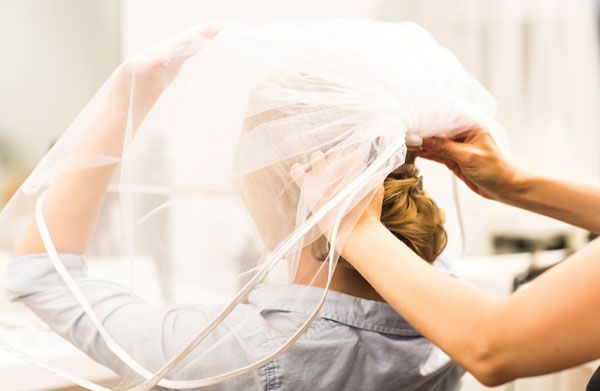Your bride has tried on an endless stream of white gowns, each more beautiful than the last. Totally overwhelmed, she ponders aloud, “Whose idea was it that brides have to wear white for their wedding, anyway?”
In a perfect world your bridal consultant would chime in with the following explanation: “Bridal gowns weren’t always white. Actually, wearing white is a fairly recent tradition. Queen Victoria started it in 1840 when she married her cousin, Albert of Saxe-Coburg. The modern custom says that the white dress symbolizes the purity of the bride. Before that, the bride often wore her best dress. Dresses stitched specifically for weddings in various cultures were done in red, blue, purple or black, and often embellished with silver or gold thread.”
Wedding customs, traditions and superstitions abound. When bridal customers wonder aloud why people do certain things at weddings and how these beliefs came to be, it’s great to be able to relate a story or two. Not only does it showcase your expertise and enhance the image of your brand but it’s also fun and can even help consultants bond with their brides.
What the Bride Wears:
It Does Mean Something
So why does a bride wear a veil? One long-held theory is that covering her face would confuse any evil spirits that may be lurking around on her wedding day. In fact, there are many examples of customs aimed at warding off whatever negative forces might disrupt the wedding or interfere with the happiness of the occasion. Separately, lifting the veil is symbolic of the bride leaving her father’s household and officially joining her husband’s home.
Another tradition suggests that wedding veils hark back to the times when marriages were arranged between two families, and the bride and groom often didn’t see each other before the ceremony. The veil ensured that the groom couldn’t change his mind when he saw the bride’s face. Early Greek and Roman brides wore yellow or red veils to represent fire and ward of demons. Talk about those uninvited wedding guests!
Brides wearing veils may also be related to the custom of the couple not seeing each other on their wedding day until the bride makes her walk down the aisle. Today, things have changed a bit. While some brides remain adamant that the groom shouldn’t see them in their wedding gown until they begin that walk, many modern couples meet for a few moments pre-ceremony to calm their nerves. Other non-superstitious engaged pairs take the opportunity to take pre-ceremony photos long before the guests arrive so they can devote the post-ceremony time to having a great time at the reception.
Why is it customary for brides to wear or carry something old, new, borrowed and blue, and perhaps a sixpence in their shoe? This tradition began in Europe, and was another instance of shielding the bride from whatever demons, evil spirits or assorted interlopers might exist in the neighborhood. Some say that something old, typically a gift from an older family member, symbolized continuity while transitioning from single to married; something new, moving into adulthood; borrowed, passing luck along from a happily married couple; and blue, purity, constancy and fidelity.
Why does the bride carry a bouquet? Because brides love flowers, of course! Seriously, this tradition might have started with the early Romans. Back in the day brides carried bunches of herbs such as garlic and rosemary under their veils to ward off evil. Bridal “bouquets” may have started out as bundles of wheat, corn or fruit, symbolizing fertility. Moving ahead to the 1500s in Europe, fragrant bouquets help camouflage the fact that baths weren’t a regular activity. It’s said that since annual baths took place in May, many weddings took place in June while the celebrants were relatively fresh.
Today’s bride may carry a single flower or an elaborate arrangement of blossoms. Bouquets may use silk blooms for the allergic or be covered in jewels. It’s also become a custom to incorporate something that has a special meaning to the bride, like a piece of lace from her mother’s or her grandmother’s wedding gown or even pieces of heirloom jewelry. Some brides may defy tradition and forgo anything bouquet-like, opting to carry something that has a special meaning to the bride or the couple, or nothing at all.
Speaking of bouquets, the custom of tossing the bouquet and throwing the garter also has origins in ancient times. Because a bride was considered to be especially lucky on her wedding day, wedding guests would sometimes attempt to take home scraps of her wedding dress as souvenirs. To save the dress from damage and still provide that good luck, brides began tossing their bouquets. Eventually, the superstition became that the single woman who caught the bouquet would be the next to marry. Brides once were the ones who tossed the garter, but this task was passed to the groom by the Fourteenth Century because brides soon tired of fighting off overzealous guests who wanted to remove the garter.
Today’s bride often asks her floral designer for a “tossing bouquet” so she can retain the real bouquet as a keepsake.
Wedding Rings:
A Lasting Symbol of Unity
Wedding rings have a long and colorful history, which can be traced back to around 2800 B.C. in Egypt. The Egyptians are credited with the phrase a circle “without beginning, without end” to describe what a wedding ring symbolizes. The earlier rings in that culture were woven of hemp and were replaced when they wore out. The Romans created their wedding bands of iron. Early Celtic rings were woven from locks of hair from the bride and groom and worn by the bride. The Venetians were the first to use diamonds when saying their vows, believing the glittering stones were created by the fires of love. Probably the first engagement ring was presented to Princess Mary, daughter of the infamous King Henry VIII, leaving her promised at the ripe old age of two.
Why is the fourth finger of the left hand the ring finger, reserved for rings of the engagement and wedding variety? Well, the ancient Romans can take the credit, it seems. Romans thought a vein in the ring finger, the “vein of love”, lead directly to the heart.
There’s also a tradition or two about the wedding ceremony itself. Why are marrying couples said to be “tying the knot”? This phrase can be traced to the custom in countries like India, Egypt and Ireland of actually tying the bride’s and groom’s hands together to signify their commitment to each other in front of witnesses.
Ever wondered why the bride stands on the left and her bridegroom stands on the right during the ceremony, thus defining the “bride’s side” and the “groom’s side?” This dates back the days when there was a chance someone would attempt to abduct the bride. If the groom needed to protect his beloved from bride-napping, he needed his right side free so that he could grab his sword. Evidently wedding crashers in past times were quite an aggressive bunch.
Some couples today go against this tradition and stand where they feel comfortable, no matter what the guidebook or wedding planner insists is the correct way. It’s also becoming more common to have signs at the ceremony read something like: “Choose a seat, not a side. We’re becoming one family today.”
Tossing rice at the newlyweds as they leave the ceremony dates back to Agrarian customs where weddings were considered good luck and showering the couple with nuts and grain was believed to bring a bountiful harvest and children to work the land. Today this custom still exists but has changed a bit with the times: couples now may be showered with the traditional rice, or another item such as birdseed, flower petals, confetti or bubbles. While some wedding sites have banned rice tossing because it is feared that birds might be harmed if they ingest it, other venues just don’t want the hassle of cleaning up after the celebrants have left the site.
About Those Attendants:
Why Do We Have Them?
Why does getting married require an entourage of bridesmaids and groomsmen? It’s been said that the first groomsmen were essentially bouncers, selected by the groom to keep any uninvited guests from crashing the wedding and keeping the party from getting too rowdy. Another explanation is that the first groomsmen came into play as assistants to the groom when the groom kidnapped the bride. For most weddings today, however, the job is chiefly ceremonial.
Bridesmaids originally were a group of well-dressed decoys, or so the story goes. Once again, brides were considered either a target for abduction – by someone other than the groom – or a magnet for some form of negative energy. So, all of the bridesmaids wore dresses that looked alike – and often just like the bride’s – to confuse those pesky spirits and again, bring luck to the couple. So, if a bride’s attendants aren’t all that thrilled about what they’re wearing to the wedding, remind them that it used to be a much bigger job!
Where there are bridesmaids there are bridal showers. This custom - and the custom of giving wedding presents - probably came from the desire of friends to ensure that a couple would have what they needed to begin married life, no matter their financial status. One story is that the first bridal shower happened in the late 1800s. At a party for the bride, her friends tucked small gifts into a parasol. When she opened it, there was a “shower” of presents.
Bachelor parties have a longer history than you might expect. And today’s pre-wedding outings for the groom and his friends may seem tame when compared to stag parties held by the ancient who said goodbye to the groom’s single days with a loud, rowdy party. Brides traditionally have been feted with showers, which now can be held for the couple as well. Bachelorette parties, sometimes called “hen parties”, a day out or night out with the girls, are a much more recent phenomenon.
After the Wedding:
Let the Party Begin
Several activities acted out at today’s weddings make a little more sense when you know their history. The wedding cake is another symbol of good luck for the couple’s future. The cake is now the elaborately themed centerpiece of many a wedding reception, although cupcake towers, dessert stations and no sweets at all are becoming more common. The wedding cake tradition is almost 2,000 years old and the first wedding cakes weren’t cakes at all, but small loaves of bread. In Roman custom, the groom ate part of the loaf and then broke the rest over the bride’s head for good luck.
Medieval English couples kissed over a pile of small loaves of bread brought to the wedding by guests. Later couples would kiss over a tower of small cakes. This may or may not have evolved over time to sometimes messily sharing a slice of the wedding cake. A baker began icing the cake tower during the reign of King Charles II of England and voila! The modern wedding cake arrived. As for saving the top layer of the wedding cake to savor on a couple’s first wedding anniversary, that’s a relatively new tradition; originally this layer was saved to celebrate the christening of their first child. Today, although the cake’s top tier often gets stashed in the freezer, many couples arrange to have their baker recreate the top layer on their anniversary rather than sample the year-old confection.
From flowers to wedding rings to attire and bridal parties, there is one thing that researching wedding customs brings to light: The most important traditions are the ones couples begin for themselves. Their wedding can incorporate any, all or none of the “traditional” touches. It’s the uniqueness of their nuptials that will be remembered.
Sources consulted for this story:
• “50 Wedding Traditions and Superstitions”, www.theknot.com
• “Who Knew? 10 Surprising Facts About Wedding Traditions”, www.brides.com
• “10 Interesting Facts About Marriage”, www.womansday.com
• “Here Comes the Bride: Women, Weddings, and the Marriage Mystique” by Jaclyn Geller (Four Walls Eight Windows, 2001)
• “Something Old, Something New: What You Didn’t Know about Wedding Ceremonies, Celebrations, and Customs” by Vera Lee (Sourcebooks, 1991).
• “A Bride’s Book of Wedding Traditions” by Arlene Hamilton Stewart (William Morrow and Co., 1995)
• “How the World Weds” by Claudia de Lys (The Martin Press, 1929)
• “Wedding Ceremonies: Ethnic Symbols, Costume, and Rituals” by Tiziana and Gianna Baldizzone (Flammarion, 2001).
• “The Wedding Book: The Big Book for Your Big Day” by Mindy Weiss and Lisbeth Levine (Workman Publishing, 2008).
• “Emily Post’s Wedding Etiquette” by Peggy Post (HarperCollins Publishers Inc., 2006)
• “Bride’s Book of Etiquette” (Perigee Books, 2002)
• “What Is Marriage For: The Strange Social History of Our Most Intimate Institution” by EJ Graff (Beacon Press, 2004).




